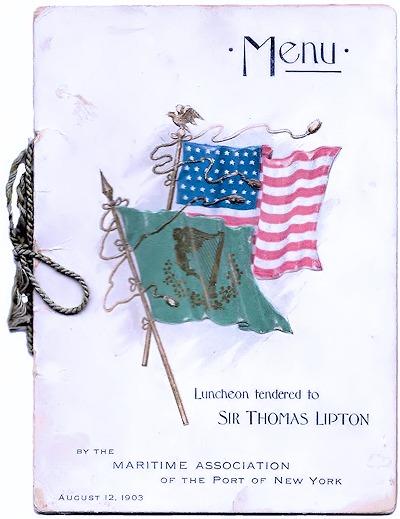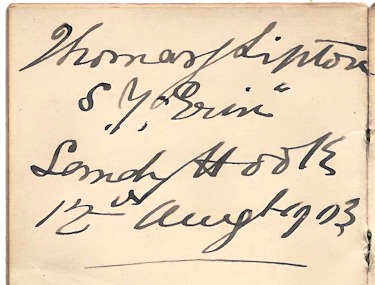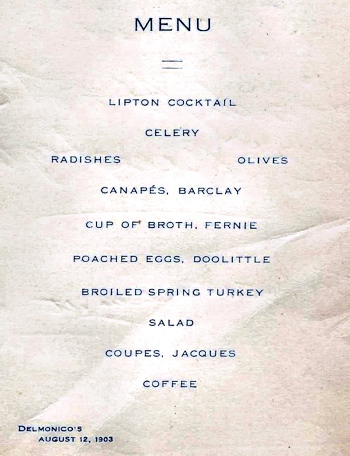 |
|
| News About Us Membership Events Links |
|
Thomas J. Lipton and the 1903 America's Cup
What ephemera is 110 years old, autographed by a famous British sportsman, from an event in the United States, and found in Canada?
The answer? It's a small 3 ½-inch by 5-inch menu from a Luncheon at legendary Delmonico's restaurant in New York, "tendered to Sir Thomas Lipton by the Maritime Association of the Port of New York." Dated August 12, 1903, the menu was for a luncheon to honour wealthy yachtsman Sir Thomas Lipton (of tea fame) when he was in New York for the America's Cup Race of 1903. What makes it much more interesting is that it has been signed by Lipton -
"Thomas J. Lipton, S.Y. Erin, Sandy Hook, 12th August 1903". Sandy Hook is a spit of land at the entrance to Lower New York Bay, south of New York City. The Erin was probably anchored there. The Steam Yacht ("S.Y.") Erin was Lipton's luxurious personal yacht, 260 feet long, with a beam of 40 feet and a crew of 40. The furnishings were magnificent, befitting the yacht of one of the Victorian era's self-made millionaires. The Erin was Lipton's accommodation while he was in New York to watch his entry in the 1903 America's Cup races, the Shamrock II. The Shamrock II was the successor to the unsuccessful Shamrock from the 1901 competition. Shamrock II was also unsuccessful, as were the later Shamrock III, Shamrock IV, and Shamrock V. The menu cover shows the American flag, and the flag of the Royal Ulster Yacht Club, a green flag displaying a harp surrounded by a garland of shamrocks. Not a member of the British upper class, Lipton was reportedly denied membership in the Royal Yacht Squadron until shortly before his death in 1931. So we know why Lipton was in New York, and why he was honoured by the Maritime Association of the Port of New York. But why did Lipton autograph the menu? The fabulously rich of the era did not consort with autograph seekers. The reference to the S. Y. Erin implies that the signing may have taken place on board Lipton's yacht, later in the day, perhaps for one of the Maritime Association's luminaries who had been invited for cocktails or dinner afterward.
But how did the menu make its way from New York City, to and across the Canadian border into an Antique Mall? And where has it been for the past 110 years? The outside back cover has a piece of surface damage in one corner, about where a Philistine would place a price sticker, so part of its journey may have included a garage sale (= boot sale). That's the only clue. And that's what is so charming about ephemera. Part of it speaks about history, an element of it hints at history, and at some levels it teases us because it even hides history. Carry on collecting. John G. Sayers (jasayers[at]saybuck.com), a resident of Canada, is in his 5th year on the Council of the Ephemera Society and his 7th year on the Board of The Ephemera Society of America and has been a keen collector of ephemera for many years.
|
This regular feature shows special items from members’ own collections. Submissions by email should include a scan of the item. |
|
Home | News | About Us | Membership | Events | Links | Contact | Item of the month | Articles |
| Copyright © The Ephemera Society 2024. All Rights Reserved. |

